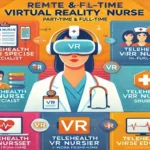Telehealth Nurse
Description
Frequently Asked Questions (FAQs)
What are the key responsibilities of a Telehealth Nurse?
As a Telehealth Nurse, your primary responsibilities include conducting remote nursing assessments, educating patients on managing chronic conditions, responding to urgent and routine health concerns, and collaborating with multidisciplinary teams to ensure comprehensive patient care. Additionally, you will leverage digital health platforms to provide accurate and timely medical guidance.
What are the biggest challenges faced by Telehealth Nurses?
A significant hurdle involves maintaining efficient patient communication in a virtual setting, as non-verbal cues may be more complex to assess. Moreover, technical difficulties like unreliable internet connections or lack of experience with telehealth platforms can pose obstacles. Staying updated with evolving telehealth regulations and best practices is also crucial to providing optimal care.
What growth opportunities are available for Telehealth Nurses?
Telehealth nursing offers multiple career growth avenues, including specialization in chronic disease management, remote triage, and virtual care coordination. Nurses can also advance into leadership roles such as Telehealth Program Manager, Clinical Educator for digital health, or even transition into healthcare technology consulting.
How does telehealth nursing compare to traditional in-person nursing?
While telehealth nursing shares many core responsibilities with traditional bedside nursing, it emphasizes remote patient interaction, technology use, and digital documentation. Unlike in-person care, telehealth nurses must develop strong virtual rapport with patients and rely on digital tools for assessment and treatment recommendations.
What technologies do Telehealth Nurses use to provide care?
Telehealth Nurses utilize various digital platforms, including video conferencing software, electronic health records (EHR) systems, remote monitoring devices, and secure messaging tools. Familiarity with these technologies is essential to ensure smooth virtual consultations and effective patient care coordination.




